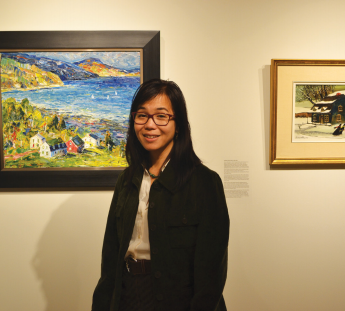The University Welcomes New Art Gallery Director

Lalaine Little enjoys her first semester as the University’s new Art
Director.
Pauly Friedman Art Gallery has a new director: Lalaine Little.
Donna Posatko, the gallery’s former director, retired last semester.
Little said she luckily discovered the job opening by chance.
“I try to be aware of all the activities in the area regarding the arts, just because it’s my field, and there are not a lot of jobs in this field,” said Little. “I had been working at the Allentown art museum, which is a good 90 minute commute, so I do try to keep in touch with the local opportunities.”
Little comes to the gallery with experience, but she was not an art major during her undergraduate education; she studied political science.
“I thought I wanted to go to law school, and then I thought, ‘Eh, maybe that’s not for me.’ So I took one of those graduate school guides, when they used to publish them in paper, and opened it, and museum studies and museum education came up,” said Little.
Little does not recommend this method of major selection for all students.
“It does fit in with what I’ve done my whole life. I’ve always been a collector, and I’ve always liked material culture. So I went to study museum education in Washington D.C., which at the time had eighty six museums, and I thought I could get through all of them in my tenure there,” said Little.
Little believed that she work in natural history museums because she held a position in the education department of the Houston Museum of Natural Science.
“I gave tours, and we had really great exhibits about the rain forest, about the La Brea tar pits in Los Angeles— all these really bizarre natural history anomalies that of course attract lots of kids, lots of attention, and they’re really tactile. There’re things to touch, and things to study – noisy things, you know. Natural history museums are just so much fun.”
After graduate school, Little worked at the Forsyth Center Galleries at Texas A&M University.
“That is a collection of art glass and paintings, so I had to learn art rather quickly on the fly. But I knew how to do programs for museums, so that part was not so difficult, and I knew about collections management, so it was more about the catching up.”
At this time she returned to graduate school and studied art history while working in Allentown.
As for the job in the Pauly Friedman Art Gallery? Little loves it.
“The students are curious and very insightful on the observations about the galleries,” said Little. “They’re also brutally honest, which I very much appreciate. The people here are very encouraging, very supportive of the arts here, and there are lots of ideas coming from both faculty and the community. So it’s a great environment to work in.”
She said she wants to bring in exhibits that will relate to students’ daily lives.
“What you read in the news, what you’re studying in class, so that when you get out of class, or when you’re thinking about what kind of research paper you want to write for a certain class, whether you’re coming out and you’re thinking about the injustices of the world, or some problems in the world that you’re wanting to solve that we can somehow bring to light, as in are there artists we can bring in who are tackling these questions? Are there artists that are expressing the same anxieties as students? Are there ways that students can better articulate their concerns by looking at artwork?”
Little said that she once came to the Pauly Friedman Art Gallery once with a Girl Scout Troop who were trying to get their art badge.
“I came here and did a lesson on Joan Miró, and we did a project where I had them reach into a paper bag and then try to draw what they thought was in the paper bag. At first they were a little bit afraid of it, but the idea was to get yourself to visualize based on emotion and based on feeling, and not necessarily based on what you see.”
Little is curious about what interests students and ways she can align those interests with exhibits.
“In my time in college exhibits they were into surrealists, and when I was in school they were really into M. C. Escher, those kinds of upside-down crazy drawings. You know, Melting Clocks by Dalí – everyone really liked that one. So now I’d like to know, are they into digital art, are they into photography?”
Little admits a personal love for installations because, she said, people can walk around them and interact with them more fully – and this fullness of experience is whate she hopes students will have with future exhibits.
Her favorite installation is called the Hydrospatial City in the Houston Museum of Fine Arts. It consists of tiny acrylic habitats that look almost like snow globes, but without the snow.
Little said the entire globe is very small. “So there’s this, and all of these bubbles are suspended from the ceiling. So in order to go through the exhibit, you have to walk around these little habitats. How they stay out without people knocking them around in this thing is so amazing, but you have to get really, really, super close to these globes to see the activity inside them, but all around you are all these tiny little habitats so the viewer really has to be immersed to get the feeling of this hydrospatial city. It’s supposed to be this sort of utopian, peaceful, environmentally sound city.”
